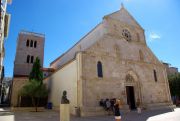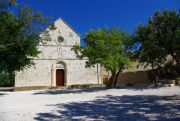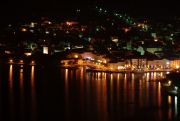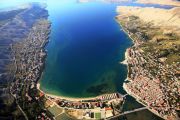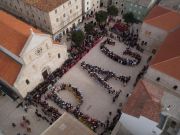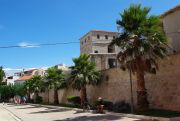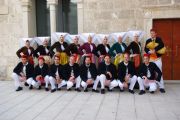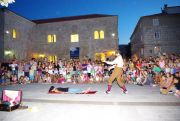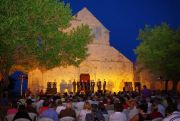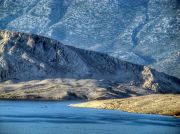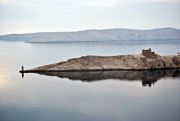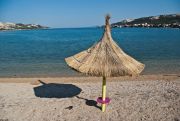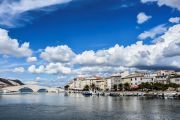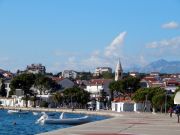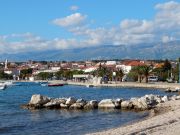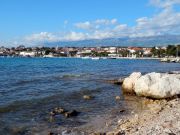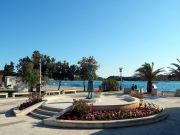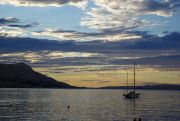Stadt Pag
The town of Pag is also the town of needlework- the famous lace. Every lace is a unique item. The slow and demanding process of making them has been nourished through centuries and still lives in the streets of the old town. The most interesting cultural and historical place on the island – the town of Pag – is not the oldest place on the island as well. One kilometer to the south, there are the remains of a settlement (a fortified convent and a church) which preceded today’s Pag – the Old town of Pag which the king Bela IV granted the status of the Royal Borough, on 30th March 1244. In 1443, the construction of the new town started according to the strict designs of Juraj Dalmatinac, Renaissance sculptor and architect. It ended two centuries later. There is the parish Church of the Assumption on the main town’s square. This church is a valuable cultural and art monument because of its exterior and interior architectural solutions, as well as the exhibits. The town abounds in beautifully carved doorposts on the entrances of the noblemen’s houses and yards, small baroque balconies, stone coats of arms from the period 15th - 18th century and a magnificent portal on the Duke’s palace. This well-preserved mediaeval town, whose center is the cultural monument, even today performs the function of the administrative, cultural and mercantile center. The Benedictine convent of St. Margarita, besides numerous valuable sacral relics and pictures, cherishes also the tradition of making “baškotini”, the aromatic crunchy biscuits that are offered at the entrance of the convent.
Island Pag
The bay of Pag is rounded by 27 km of the gravel and sandy beaches. Beside 4 hotels, the town offers trendily equipped capacities in private accommodation. During the summer season, the winter (in February) and summer (at the end of July) carnivals, there is a rich cultural and entertainment program. “Pag’s Slave girl”(a kind of a “miracle play”), folklore, the carnival wheel dance (so called “kolo”) accompanied by the brass band, old folk costumes, old songs and dances with “mišnjice”, (a kind of an instrument) are the distinguished parts of the centuries-long tradition.
In a dry-land continuation of a shallow bay hides yet another natural wealth – mud which has been tested and proved to be curative.
The nearby village with motor camp and marina in the bay Šimuni is a fishing village with a good perspective in tourism. The motor camp Šimuni is the biggest and the best-equipped camp on the island, located throughout the length of the gravel beaches. Marina Šimuni is situated to the north of the village Šimuni in a sheltered little cove.
The characteristic relief of the island of Pag is shaped by the low shore area which spreads from the bay of Košljun further to the northwest, up to the cove and port Proboj, and to the southeast up to the cove and port of Povljana. The inhabitants of Povljana were the last on the island that engaged in tourism. The vast area of the village is covered with rich vineyards. There are no larger tourist facilities in Povljana, so the offer bases on the private accommodation. Two sites that should be visited by all means are the early Croatian church of St. Nikola from the 11th century and the ornithological reserve Velo blato on the way to the village Vlašici.
On the sunny side of the island, to the north of the cove Šimuni and towards the islands Maun and Škrda, a village with a homonymous port - Mandre, has been developing as a place of individual tourism. It is a seaside resort of the inhabitants of the nearby Kolan – the only village on the island that is not situated directly on the seaside. There is an ethnographic collection in the center of this village. In the mid 1980s, the first tourist village called Gajac was constructed to the north of the port Mandre.
Košljun, Smokvica, Vlašici, Dinjiška and Miškovici are lovely and peaceful island villages that have directed their future at tourism because of their geographical position on the coast and the kindness of nature.
The island of Pag offers unusual shapes, wild exoticism, gentle oasis, hiking trails and shallow bays. Visiting all these places might last even several days. Going round the north side of the island is recommended strictly during the summer, when everyone with even a little bit of investigator mentality would experience an unforgettable adventure away from the throng, in a particular world of the rocks and the sea.









